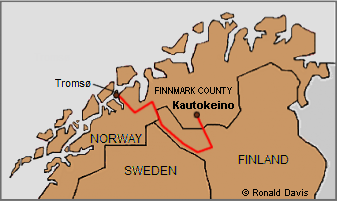

Return to the Home Page
Stanley Roseman - An Artist's Journal
Stanley Roseman - An Artist's Journal
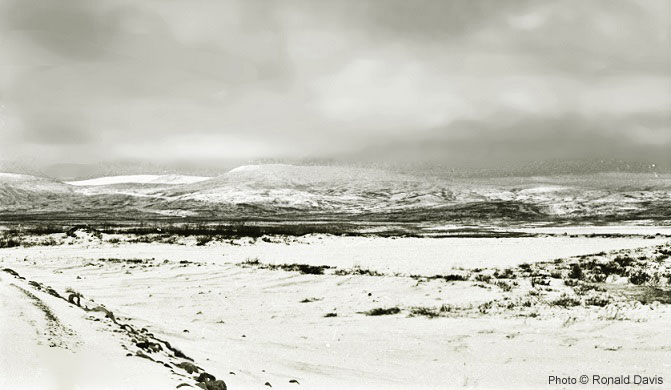
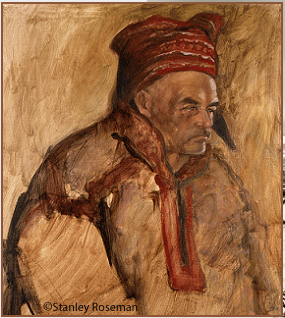
Bier An'te (detail), 1976
Reindeer Herder, Lappland
Oil on canvas, 98 x 80 cm
Collection of the artist
Reindeer Herder, Lappland
Oil on canvas, 98 x 80 cm
Collection of the artist
Tundra in the rural township of Kautokeino, Finnmark County, northern Norway, 1976.
The Saami People of Lappland
"The Saami paintings are magnificent.''
- The Times, London
Bier Ante Ris'ten, a neighbor of Anderson in the hamlet of Soaht'tofiel'bmá, twelve kilometers from Kautokeino Village, greatly encouraged Roseman in his work. The artist speaks warmly of the Saami woman and recounts: "Ris'ten invited Ronald and me to meet her parents and thoughtfully asked if I would like to bring my painting materials."
The Bibliothèque Nationale de France states in a biographical essay on Stanley Roseman that the artist has "a profound interest in the human condition in portraying different kinds of people, professions, social or artistic groups."[1]
Roseman's interest in the nomadic Saami took the artist and his colleague Ronald Davis in 1976 beyond the Arctic Circle to the windswept tundra in the interior of Norwegian Lappland. There Roseman brought to realization what The Times of London praises as "an epic project." In Lappland, the artist painted a series of critically acclaimed portraits of the Saami, a hardy, independent, reindeer-herding people who maintain their centuries-old, nomadic way of life in one of the earth's harshest environments. Roseman recounts in his journal:
''Leaving New York City that September, I felt a kinship with Gauguin, who had left a great metropolis and flourishing art center, Paris, to seek inspiration for his work among a group of people living in a remote part of the world - for him, native Tahitians, in the South Pacific; for me, nomadic Saami, beyond the Arctic Circle."
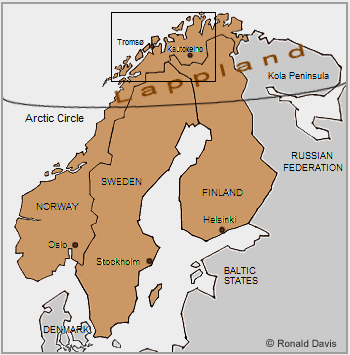
The Journey
In early September 1976, Roseman and Davis boarded a flight from New York to Oslo and traveled north by train and bus some 2,250 kilometers to Tromsø. The city, home to the world's northernmost university, is located on an island connected to the mainland by a kilometer-long cantilever bridge.
In Tromsø, Roseman and Davis were befriended by a kindly Norwegian couple, Kai and Kirsten D., who were excited about the artist's prospective project and wanted to contribute to a successful realization of the work. Kai thoughtfully offered the use of the family car to the two adventurers as he had the use of a company car where he worked.
With well wishes from their new Norwegian friends, Roseman and Davis left Tromsø and drove some 400 kilometers on the one main road that led them east through Norway and into Finland, from where they travelled southeast before turning north to recross the Norwegian border into Finnmark County and on to the rural township of Kautokeino, situated just above the 69th parallel.
3. Lappland, also spelled Lapland, the ancestral home of the Saami, or Lapps, comprises northern Norway, Sweden, Finland, and the Kola Peninsula of Russia.
''But once there, would I meet individuals willing to sit for a portrait as the Saami are a mobile people who follow the seasonal migrations of the reindeer from elevated pastures along the seacoast in spring and summer to the bleak tundra, where October snowfalls announce an early winter and daylight hours diminish with increasing rapidity."
Roseman and Davis stayed in Tromsø a few days to acclimate to the Arctic region and to do additional research on the Saami culture before making their way to the interior of Lappland.
Kautokeino
Anderson, highly respected among the Saami, thoughtfully introduced Roseman to those whom she felt would be responsive to the idea of sitting for an artist, for the Saami, being a nomadic people, do not have in their culture the tradition of portraiture, particularly life-size, oil on canvas portraits. Roseman and Davis were invited by Anderson to meet her friend Sunne Ris'ten and her husband Issát, who kindly gave of their time to the artist so that he could include portraits of the Saami couple in his work in Lappland.
The Saami and the Artist
4. Issát (detail), 1976
Reindeer Herder, Lappland
Oil on canvas, 120 x 120 cm
Private collection, Switzerland
Reindeer Herder, Lappland
Oil on canvas, 120 x 120 cm
Private collection, Switzerland
The reindeer herder Issát, following the winter migration of the reindeer, had returned with Sunne Ris'ten and their children to the region of Kautokeino. Invited into the couple's winter dwelling on the tundra, Roseman painted the magnificent portrait Issát, (fig. 4).
In the last quarter of the twentieth century, the Saami, a numerically small, indigenous minority, accounted for less than one percent of the combined population of Norway, Sweden, and Finland. Finnmark County, Norway, is inhabited mostly by Saami. The majority of the Saami in Lappland have assimilated into the dominant culture and are commonly engaged in farming, fishing, and other sedentary occupations. Some ten percent of the Saami are reindeer-herding nomads, whereas in northern Norway the percentage is much higher.[2] The Saami speak their own language, Saami, of the Finno-Ugric language group, and wear their traditional clothing, as does Issát in the Roseman portrait.
Aftonbladet, Stockholm, Sweden's leading daily, published a cover story on Roseman in its Sunday magazine and commends him for painting portraits "on a high artistic level as well as accurately expressive of the human dimension."
- Aftonbladet, Stockholm
"Roseman's Saami paintings. . . . They give an overwhelming sense of individuality and humanity."
For Roseman to accomplish his work in Lappland, he and Davis had to adapt to an unfamiliar environment and overcome challenging physical and climatic conditions. The artist's ability to be mobile, as are the Saami; his empathy with his models; and the resultant paintings earned him respect and admiration. Despite the reserve that the Saami held towards those outside their community, a rapport of trust and understanding was established between the Saami and the artist.
5. Bier Ante Ris'ten (left); Davis (center), carrying the artist's paint box and portable easel; and Roseman (right), carrying his canvases and bag of painting supplies, as they prepare to cross the Cábardasjohka River in a rowboat to the winter cabin of Ris'ten's parents who lived on the opposite bank.
Roseman painted impressive portraits of Ris'ten's mother Biret and Ris'ten's father Bier An'te, a reindeer herder, presented at the top of the page and here, (fig. 6).
The rowboat transported Ris'ten, her brother who had come to get them, Ris'ten's nephew An'te Niilas, Anderson, Davis, and Roseman. Kautokeino, 1976.
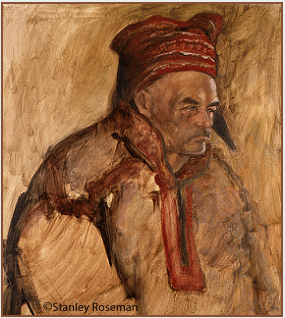
6. Bier An'te (detail), 1976
Reindeer Herder, Lappland
Oil on canvas, 98 x 80 cm
Collection of the artist
Reindeer Herder, Lappland
Oil on canvas, 98 x 80 cm
Collection of the artist
"Bier An'te, a robust and amiable older man, was waiting for us when we arrived and escorted us inside," the artist recounts. "He expressed interest in my art materials and portable easel, which made me feel especially welcome. Bier An'te was a wonderful and enthusiastic model whose physiognomy and weathered complexion revealed a long, hard life as a reindeer herder in the harsh Arctic terrain.''
Roseman's superb oil on canvas portrait Bier An'te, (fig. 6), is imbued with earth colors of umber and sienna. The reindeer herder seems to emerge from the painterly background, emphasizing the close relationship between the man and his environment.
The artist has rendered with a sculptural quality the strong facial features of the Saami man, whose presence fills the composition. He wears a traditional Saami hat with bands of red, yellow, and white braiding and dark, tubular forms of woolen material that fall to the side and back. His heavy, woolen tunic is described by the artist with bold, vigorous brushstrokes that give a sense of pending movement to the figure. Bier An'te's pensive gaze seems to take him far into the distance of Lappland that the Saami reindeer herder knew so well.
During the days the artist was at work on his portraits at the home of Ris'ten's parents, the weather grew much colder, and the Cábardasjohka River froze over. Roseman recounts the circumstances leading up to and including the eventful recrossing of the frozen river, with accompanying photographs, on the Journal website page "Remembering Bier Ante Ris'ten from Lappland."
The website page features Roseman's equally superb portrait painting of Ris'ten. Roseman also speaks about painting a portrait of Ris'ten's nephew An'te Niilas, who was orphaned as a boy and raised by Ris'ten and her husband. The artist warmly remembers Ris'ten for her encouragement of his work, for her gracious hospitality, and as the artist writes, "for kindly sharing with me a part of her family life and the Saami culture."
"My contact with the Saami was an enriching experience for my art and for my life,
more than I had hoped for or could have foreseen
when Ronald and I started out on our journey to Lappland."
more than I had hoped for or could have foreseen
when Ronald and I started out on our journey to Lappland."
- Stanley Roseman
Roseman's Empathy with his Models
"The subjects that occupied me as a young artist and my own thoughts and feelings about my work led me to abandon the belief, especially strong in the mid-twentieth century, that held the traditional artist's studio in reverence as a creative milieu. More and more I sought the environments of my models in which to paint and draw. While unfamiliar environments meant adjusting to new working spaces and conditions of light and often much activity around me, I ultimately found such circumstances conducive to my own creative process."[3]
7. Roseman painting a portrait of Mát'te, who kindly sat for the artist in the reindeer herder's winter dwelling in the hamlet of Soaht'tofiel'bmá, Kautokeino Township, 1976.
Of the intaglio printing techniques, the process of drypoint engraving is most akin to drawing. The artist draws directly into a copper or zinc plate with a sharp-pointed metal stylus which leaves minute ridges of metal called "burr'' to the incised lines that hold the ink when printed. The aesthetic quality of drypoint, as well as the technical process that limits the number of impressions pulled from a single plate, has a great appeal to connoisseurs of prints.
8. A Saami Woman, 1977
Drypoint, 15 x 9.5.cm
Bibliothèque Royale de Belgique,
Brussels
Drypoint, 15 x 9.5.cm
Bibliothèque Royale de Belgique,
Brussels
"In the hamlet of Soaht'tofiel'bmá, where several houses stood on the bleak, wintry tundra," Roseman writes of his Lappland journey, "Myrdene introduced me to the reindeer-herder Mát'te, who kindly invited us into his home and generously gave of his time to sit for a portrait.
"I set up my portable easel and canvas in a room that served as the family's main living quarters, with table, chairs, and a wood-burning stove,'' further recounts the artist. "Mát'te wore his Saami hat and belted, thick, woolen tunic, and he smoked a cigarette. On the other side of the room, Mát'te's wife In'ger An'ne, their teenage daughter In'ger El'la, and another woman were going about their chores. While I painted his portrait, Mát'te thoughtfully gave me his full attention, which I sincerely appreciated for my work.'' Roseman's superb portrait of the reindeer herder is presented below, (fig. 12).
On Roseman's return to New York City, he created a suite of drypoint engravings as a complement to his paintings from Lappland. In keeping with the earth tones in the Saami paintings, Roseman printed the drypoints in Charbonnel bistre ink on beige paper. The Saami People of Lappland suite was published by Ronald Davis in 1977 in a limited edition of 15 portfolios presented in custom-made, leather and linen box cases with gold-leaf stamping. The edition was announced in the respected quarterly Master Drawings. Roseman dedicated the edition to Myrdene and to Kai and Kirsten, whose valuable contributions were most important in bringing to realization the artist's work in Lappland.
Yale University's Peabody Museum presented The Saami People of Lappland exhibition in September-October 1977. Discovery, the biannual journal of the Peabody Museum, published an enthusiastic reportage on the exhibition and praised ''this handsome assemblage devoted to a remote but unique society."
The international news agency Agence France Presse covered the Yale University exhibition and writes:
Portraiture
''The exhibited portraits are larger than life," writes The Morning Record & Journal. "Detail in the portraits is concentrated in the faces and sometimes in the hands. These are opaquely painted in full modeling, each strong, expressive, and individual.''
Mát'te is a commanding presence in the superb portrait, (fig. 12). The reindeer herder with blue eyes, prominent cheekbones, and ruddy complexion wears his Saami hat and heavy, woolen tunic and holds a hand to his lips as he smokes a cigarette and looks out from the canvas. Here, as in other Roseman portraits of the Saami, "the clothing is painted boldly, but in masses suggesting its form and bulk," observes The Morning Record & Journal.
12. Mát'te (detail), 1976
Reindeer Herder, Lappland
Oil on canvas, 117 x 86 cm
Private collection
Reindeer Herder, Lappland
Oil on canvas, 117 x 86 cm
Private collection
"The Saami paintings are magnificent.''
- The Times, London
The Morning Record & Journal, Meriden, Connecticut, entitled its laudatory review ''Art and Anthropology at the Peabody.'' The Connecticut daily praises ''The excellent exhibit'' and commends the successful collaboration between artist Stanley Roseman and anthropologist Myrdene Anderson, who had returned to Yale University, where she earned her doctorate degree the following year.
The Saami People of Lappland exhibition featured Roseman's paintings with a selection of artifacts and documentary information from the collections of Myrdene Anderson and the Peabody Museum.
11. Stanley Roseman, Myrdene Anderson, and Ronald Davis
standing before the artist's portrait of the reindeer-herder Mát'te
at the opening of the exhibition The Saami People of Lappland,
Peabody Museum, Yale University, 1977.
standing before the artist's portrait of the reindeer-herder Mát'te
at the opening of the exhibition The Saami People of Lappland,
Peabody Museum, Yale University, 1977.
''The creation of the portraits of these nomads, an endeavor especially difficult in light of their seasonal migrations, fostered a close relationship between the Saami and the artist, who became their temporary companion. The exhibition constitutes an ethnological and artistic work that has never been brought to such a successful realization.''
10. Peabody Museum, Yale University
The panel reads: "The Saami People of Lappland
Paintings by Stanley Roseman."
The panel reads: "The Saami People of Lappland
Paintings by Stanley Roseman."
- Agence France Presse
The Peabody Museum journal Discovery writes that the exhibition was produced by Ronald Davis in association with Keith Stewart Thomson, Director of the Peabody Museum; Myrdene Anderson; Louise Lauretano DeMars, Senior Exhibit Designer; and the Museum's curatorial staff.
In the photograph, (fig. 10), are the artist's oil on canvas portraits of (from left to right) Biret; Bier An'te, a portrait of the reindeer herder wearing his white reindeer fur coat (see previous page, fig. 7); and An'te Niilas, the Saami couple's teenage grandson.
© Stanley Roseman and Ronald Davis, 2014 - All Rights Reserved
Visual imagery and website content may not be reproduced in any form whatsoever.
Visual imagery and website content may not be reproduced in any form whatsoever.
The Saami People of Lappland Edition of Drypoint Engravings
A few days after Roseman and Davis arrived in Kautokeino, they chanced upon meeting Myrdene Anderson, today a distinguished anthropologist, botanist, and linguist, who was then, in 1976, completing five years of field work as a graduate student from Yale University. Anderson was enthusiastic about Roseman's interest as an artist in the nomadic Saami. She thoughtfully offered him and his colleague to be their guide in helping them become acquainted with the region and the people, and she very kindly took on the task of translator as Roseman and Davis spoke neither Norwegian nor the Saami language. "I learned very much from Myrdene about the Saami culture," recounts the artist, "and I am deeply grateful for her encouragement and enthusiasm for my work.''
© Ronald Davis
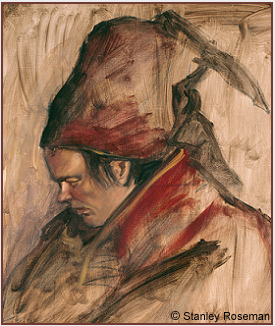
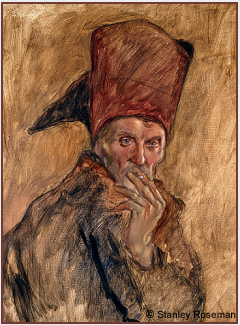
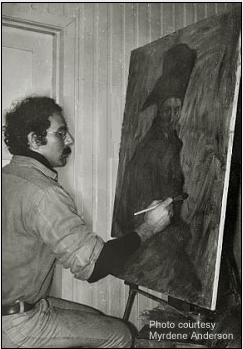
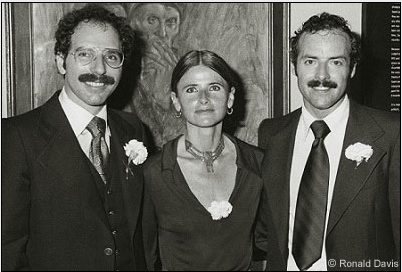
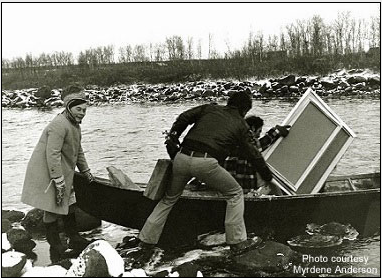
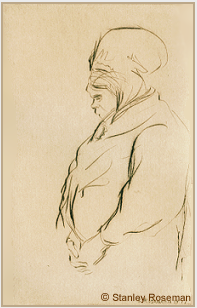
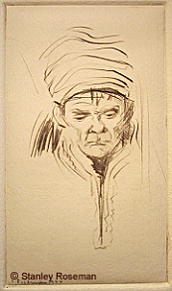
The arduous life of the nomadic Saami, of whom women are actively engaged in reindeer herding as are the men, is here contrasted by this sensitive image of a Saami woman in a quiet moment of personal reflection.
1. Stanley Roseman - Dessins sur la Danse à l'Opéra de Paris - Drawings on the Dance at the Paris Opéra
(text in French and English), (Paris: Bibliothèque Nationale de France, 1996), p. 11.
2. Myrdene Anderson, "The Saami Reindeer-Breeders of Norwegian Lapland,"
(American Scientist, Vol. 73, No. 6, November-December, 1985), p. 527.
3. Stanley Roseman, Stanley Roseman and the Dance - Drawings from the Paris Opéra
(Paris: Ronald Davis, 1996), p. 12.
4. Anderson, "The Saami Reindeer-Breeders of Norwegian Lapland," p. 532.
(text in French and English), (Paris: Bibliothèque Nationale de France, 1996), p. 11.
2. Myrdene Anderson, "The Saami Reindeer-Breeders of Norwegian Lapland,"
(American Scientist, Vol. 73, No. 6, November-December, 1985), p. 527.
3. Stanley Roseman, Stanley Roseman and the Dance - Drawings from the Paris Opéra
(Paris: Ronald Davis, 1996), p. 12.
4. Anderson, "The Saami Reindeer-Breeders of Norwegian Lapland," p. 532.
The Saami People of Lappland suite includes the beautiful drypoint engraving entitled A Saami Woman, (fig. 8). Wearing a traditional Saami bonnet and fringed shawl, the woman stands in repose, with head inclined, arms down, and hands folded. Roseman has expressed the standing figure with nuanced drypoint lines - from fine detail rendering of the woman's face in profile to dark, incised lines enhanced by the velvety burr in depicting the bonnet, shawl, and tunic. The artist has composed an effective mis-en-page in the placement of the figure. With an economy of line, Roseman conveys a strong presence of the individual.
9. Portrait of a Saami Man, 1977
Drypoint, 10 x 5.5.cm
Bibliothèque Royale de Belgique,
Brussels
Drypoint, 10 x 5.5.cm
Bibliothèque Royale de Belgique,
Brussels
''Art and Anthropology at the Peabody.''
From The Saami People of Lappland suite of drypoint engravings in the Bibliothèque Royale de Belgique is the impressive Portrait of a Saami Man, presented here, (fig. 9). The intimate head and shoulders portrait depicts the reindeer herder, with eyes lowered, absorbed in thought.
Roseman renders with fine lines and crosshatched shading the lean visage, furrowed brow, and firmly set mouth of the Saami man, whose physiognomy is expressive of the nomad's arduous life with "scarce resources under conditions fraught with risk and uncertainty,''[4] on the windswept tundra of Lappland.
A portfolio of The Saami People of Lappland drypoint engravings is conserved in the Bibliothèque Royale de Belgique, Brussels. The renowned collection of prints and drawings of the Royal Library has a number of works by Roseman, including drawings from his sojourns in Belgian Trappist monasteries in 1978, at the outset of his work on the monastic life. The Bibliothèque Royale de Belgique acquired drawings the artist created at the Metropolitan Opera premiere in 1977 of Benjamin Britten's opera Death in Venice, based on the novella by Thomas Mann. Further acquisitions, from Roseman's oeuvre on the dance at the Paris Opéra, are drawings of Belgium's Rosas Dance Company in a guest appearance at the Paris Opéra in 1993.
The Saami People of Lappland Exhibition at the Peabody Museum, Yale University
Relating his memorable experience painting the portrait of Mát'te, Roseman writes: ''It is customary that when the nomadic Saami begin a task they continue until the work is completed, and Mát'te projected this Saami way of doing things by kindly sitting for me as long as I needed for my work. . . . And it seemed as though Mát'te smoked that one hand-rolled cigarette throughout the time I painted his portrait, when in fact Mát'te rolled and smoked several cigarettes in succession and thoughtfully held his pose while he sat for me that afternoon."
Roseman describes the direction of light on the cylindrical volume of the Saami man's hat, sewn with bands of fabric, by incising into the metal plate a gradation of line enriched by the drypoint burr. A few strands of hair emerge from under the hat and onto the forehead. The decorative braiding on the tunic and high collar are summarily indicated. Strong parallel strokes behind the man's right shoulder set the figure in pictorial space.
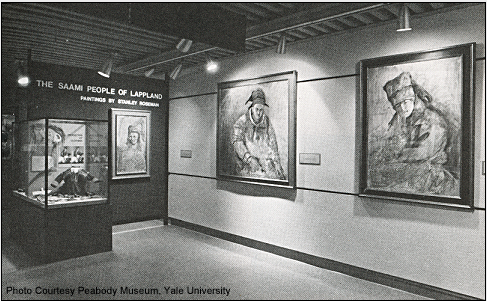

The collector of the portrait Issát writes in a cordial letter in 1993 to Roseman:
"I'm fairly sitting in a daze, not quite believing that one of your beautiful Saami paintings is now adorning a wall in my home. The painting radiates such powerful feelings, which is truly inexplicable. Yet I guess it can be explained through the fact that you lived with these people and experienced their way of life. And that is what makes you such a great artist, Stanley - your ability to perceive these people's feelings and to capture them with your brush. I am truly thrilled and proud to have this magnificent painting."
- D.E.
Switzerland
Switzerland
Earth colors in the painting evoke the hues of the stark Arctic terrain in early winter. The reindeer herder, who confronts the harsh, natural elements in maintaining his nomadic way of life, is portrayed here in a moment of introspection. "The painting radiates such powerful feelings," writes the artist's longtime collector who acquired the portrait of Issát.
The composition centers on the Saami man's face, seen in profile. With fine chiaroscuro modeling, Roseman renders Issát's facial features, ruddy complexion, and warm highlights on his forehead, cheek, and the bridge of his nose. Vigorous brushstrokes and bold abstractions define the reindeer herder's hat and heavy, woolen tunic with its protective, high collar. The hat, with dark tubular forms of material emerging from the crown and falling to the back and side, is the traditional headgear worn by Saami men from the region of Kautokeino.
